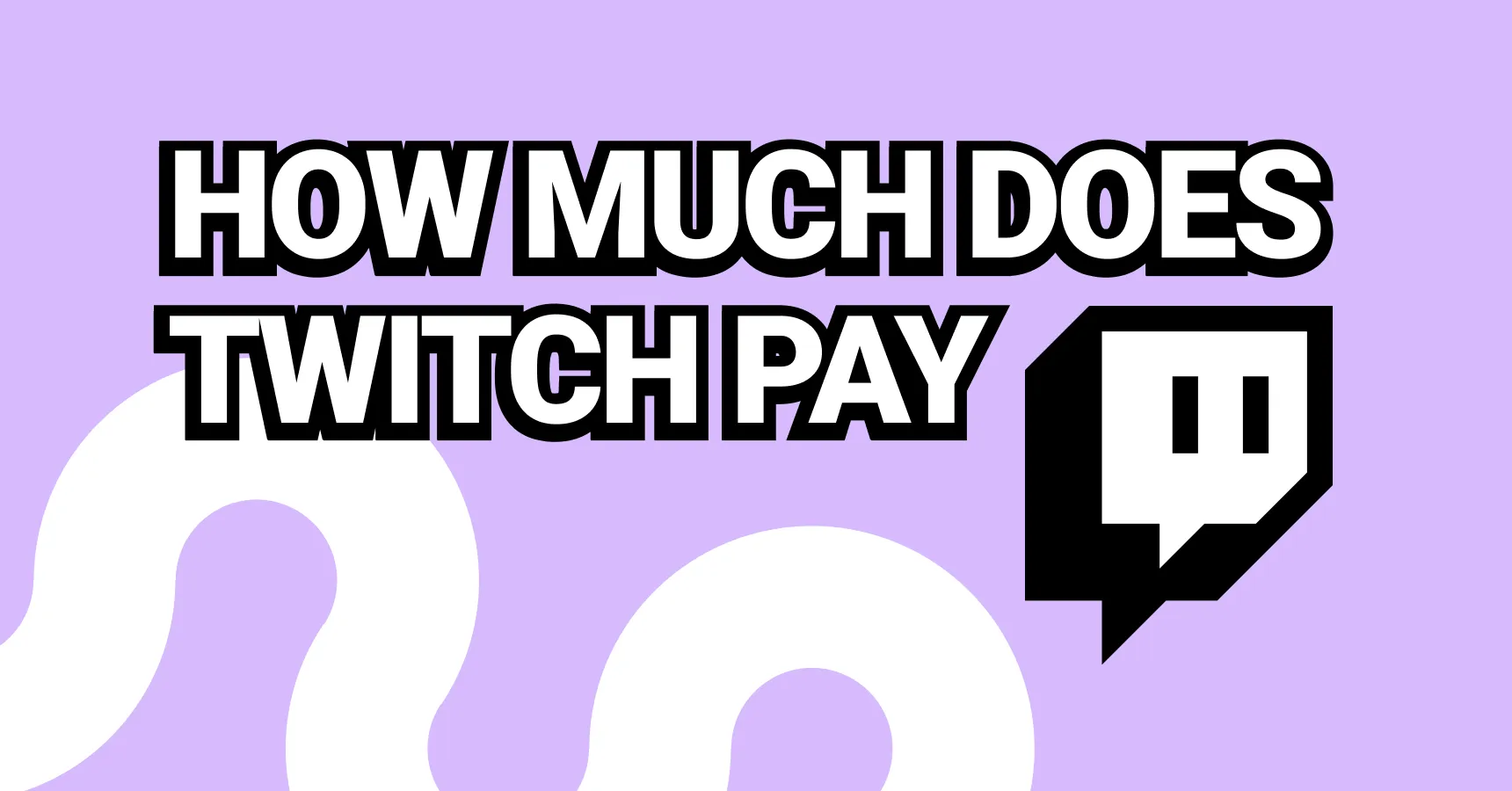How Much Does Twitch Pay? (Earnings Breakdown)

You’ve probably wondered, how much does Twitch pay if you decide to turn streaming into a side income – or even a full-time gig. It’s one of those questions that seems simple at first glance but quickly gets messy. The truth is, Twitch earnings vary wildly depending on your audience, consistency, and the monetization methods you use.
Many people jump in thinking they’ll earn a fixed number of dollars per hour they stream. That’s the myth. The reality is more nuanced. You might start small, earning a few dollars from a handful of viewers, and then, as your audience grows, the numbers can ramp up dramatically.
Whether you’re curious about side income, dreaming of a full-time streaming career, or just exploring your options, knowing the landscape of Twitch earnings can help you make smarter decisions. Let’s take a closer look at what influences income, without overcomplicating things.

Twitch monetization mechanisms
Before we dig into the numbers, it helps to understand how Twitch pays. Without this foundation, the earnings ranges can feel arbitrary. Twitch monetization works through several streams, each with its own rules and percentages.
Affiliate vs Partner
First, you need to know the difference between Twitch Affiliates and Partners. Affiliates are essentially entry-level earners on Twitch. They can accept subscriptions, bits, and a few other revenue streams. Partners, on the other hand, are more established, have higher revenue splits, and can earn from a broader set of monetization tools.
Core revenue streams
- Subscriptions: Viewers can subscribe to your channel at Tier 1, Tier 2, or Tier 3 levels. Twitch generally takes a 50/50 cut for Affiliates, but Partners can negotiate better splits, sometimes up to 70/30. Prime subscriptions count like Tier 1, and they cost viewers nothing beyond their Amazon Prime membership.
- Bits/cheers: Bits are Twitch’s in-platform currency. Viewers “cheer” using Bits, and each Bit translates into a few cents for you. It’s small individually, but with an engaged audience, it adds up.
- Ad revenue: Ads run during your stream, including pre-rolls and mid-rolls. CPMs (cost per thousand impressions) can vary, and Affiliates earn a smaller cut than Partners.
- Game sales / affiliate revenue: If you play a game that’s available on Twitch’s affiliate program, you can earn a commission when viewers buy it through your channel link.
- Donations and gifts: While outside Twitch’s direct payment system, donations via PayPal or Patreon and gift subs from viewers contribute to income.
Payout rules
Twitch pays out monthly, usually about 15 days after the end of the month, as long as your balance exceeds $100. If your balance is below that, it rolls over to the next month. Taxes, regional payment processing fees, and currency conversions can reduce what you actually receive.
Transitioning from mechanics to real numbers, it’s clear that revenue streams are varied, and income depends heavily on engagement and audience size.
How much Twitch pays: Estimated ranges
Now that you know the mechanisms, let’s explore realistic earnings. People often ask, “how much does Twitch pay?” but the answer isn’t one-size-fits-all. We’ll break it down by streamer tiers: small, mid, and top.
Small/beginner streamers
For those just starting out, maybe with 5–50 average viewers, income is modest. With only a handful of subscribers and some Bits from loyal viewers, you might earn anywhere from $50 to $500 per month. Consistency is key at this stage. Streaming three times a week might not seem like much, but those small numbers compound as your audience grows.
Mid-tier streamers
Once you hit around 100–1,000 viewers per stream and secure 100–500 subscribers, earnings can jump to $1,000–$10,000 per month. Ad revenue starts to matter more at this level, as the CPMs kick in with larger audiences. Gifted subs also become a meaningful part of income, with communities often rallying to support their favorite streamer.

Top-tier/influencer level
Streamers with tens of thousands of viewers, thousands of subs, and sponsorship deals can earn $50,000 to $200,000+ per month. Here, ad revenue, Bits, subscriptions, and affiliate sales all contribute significantly. However, these numbers are far from guaranteed and often fluctuate based on time of year, trends, and viewer engagement.
It’s important to understand that these ranges don’t include the costs of streaming, such as equipment, software, and time invested. Even a top-tier streamer has expenses that chip away at the gross earnings.
Revenue breakdown & detailed math
Let’s dig into the math. Understanding exactly how each revenue stream contributes helps you see how your own income could scale.
1️⃣ Subscription revenue
Tier 1 subscriptions cost $4.99 per month. For Affiliates, Twitch takes 50%, so you get roughly $2.50. If 200 viewers subscribe at Tier 1, that’s $500 monthly. Add a few Tier 2 ($9.99) or Tier 3 ($24.99) subs, and suddenly, your numbers climb.
Prime subs are included in this calculation, but they don’t bring extra cost to the viewer – they count as Tier 1 revenue for you.
2️⃣ Bits/cheers
Viewers buy Bits from Twitch and then donate them to you.
Each Bit is worth about $0.01 to the streamer. If you receive 1,000 Bits, that’s $10.
Not huge alone, but regular cheering can make a small channel sustainable. Some streamers earn hundreds monthly just from Bits, depending on their engagement and community culture.
3️⃣ Ad revenue
Ads can vary a lot.
CPMs may range from $2 to $10 per 1,000 views depending on region, viewer demographics, and time.
Affiliates usually get a lower cut. Running ads at optimal times without overwhelming viewers is essential. Too many breaks, and engagement drops; too few, and you leave money on the table.
4️⃣ Game sales & commissions
If a streamer promotes a game on Twitch that’s part of the affiliate program, they earn a cut from any sales generated via their link.
Usually, it’s around 5–10% of the purchase.
It’s not huge, but it’s a nice bonus for playing and recommending games your audience likes.
5️⃣ Donations & third-party income
Outside of Twitch’s system, donations and gifts add flexibility. Some streamers encourage PayPal or Patreon donations with perks like behind-the-scenes content or personal shoutouts. Though less predictable, these streams often reward highly engaged audiences generously.

Mini example calculation:
200 Tier 1 subs: 200 × $2.50 = $500
500 Bits: 500 × $0.01 = $5
Ads: 3,000 impressions × $5 CPM / 1,000 = $15
Game affiliate sales: $50/month
Total: ~$570
This shows how multiple streams, even small individually, add up to a sustainable income when combined.
Case studies & real-world examples
Seeing numbers in isolation is one thing, but understanding them in context makes the picture clearer. Many aspiring streamers ask themselves, “Can I actually make a living on Twitch?” Let’s look at a few realistic scenarios.
Mid-tier streamer example
Imagine a streamer with 500 average viewers per stream and about 300 subscribers. With Tier 1 subs at $4.99 and a 50/50 split, they earn roughly $750 monthly from subscriptions. Add in 2,000 Bits per month (≈$20) and ad revenue from around 10,000 ad impressions per month (≈$50), and you’re looking at roughly $820–$850 monthly before taxes.
It may seem modest, but consistency and community engagement play a huge role. Gifted subs can bump that number higher, sometimes by hundreds of dollars, without increasing viewer count.
Top-tier streamer example
Now consider a streamer with 10,000 average viewers and 5,000 subscribers. With a mix of Tier 1, Tier 2, and Tier 3 subs, this could easily translate to $20,000–$30,000 from subscriptions alone. Add ad revenue ($5,000–$10,000 depending on CPM and frequency), Bits (≈$2,000), and game affiliate commissions ($500–$1,000), and monthly income can surpass $30,000–$40,000.
Of course, these numbers assume active engagement and consistent streaming. One month with lower viewership can significantly reduce ad and subscription revenue.
Hypothetical growth scenario
Let’s say you start as a small streamer earning around $200 per month. By focusing on community engagement, promoting subscriptions strategically, and streaming consistently, you could reach the mid-tier level in 6–12 months, potentially earning $1,000–$2,000 monthly. It’s a gradual climb, not an instant payout.
These examples show that earnings are not just about hours streamed but also about strategy, engagement, and leveraging multiple revenue streams.
Factors that cause big swings in earnings
If you’re asking how much does Twitch pay, it’s crucial to understand why two streamers with similar audiences can earn vastly different amounts. Several factors influence income variability:
👥 Audience engagement & retention
Not all viewers convert to subscribers or cheer with Bits. A highly engaged audience is more likely to spend, so focusing on engagement – chat interaction, polls, community events – matters as much as viewer count.
🎯 Content niche & demographics
Some niches naturally attract higher-paying viewers. For example, gaming channels focused on competitive or trending games often see more Bits and subscriptions than niche hobby streams. Audience demographics, like location and disposable income, also affect ad revenue and subscriptions.

🗓️ Streaming consistency & schedule
Viewers like predictability. Streamers with consistent schedules and frequent streaming hours tend to maintain and grow their audience faster, which directly impacts revenue. Gaps in streaming can cause a sudden drop in subs and ad impressions.
⚖️ Platform policies & algorithm changes
Twitch can change subscription splits, ad algorithms, or introduce new monetization tools. Even small policy shifts can affect income, especially if your revenue relies heavily on a single stream.
💸 Taxes, fees, and currency conversion
Income on Twitch is reported gross. Taxes, transaction fees, and currency conversions can reduce what actually hits your bank account. Planning for these deductions is essential, particularly if you aim for full-time income.
🔥 Burnout and competition
Many underestimate the mental load of streaming. Hours of entertaining, interacting, and managing content while competing with thousands of other streamers can take a toll. Burnout can temporarily or permanently reduce earnings, regardless of audience size.
Understanding these variables helps frame realistic expectations and encourages smarter planning rather than blind chasing of numbers.
Strategies to increase Twitch income
Now that you understand how much Twitch pays and what causes fluctuations, let’s focus on strategies to grow your revenue. The key isn’t just more hours; it’s smarter leverage and community engagement.
✔️ Grow your subscriber base
Offering incentives for subscriptions can make a big difference. Custom emotes, subscriber-only chat, or special recognition during streams encourages viewers to commit. Even a small increase in subscribers can translate into hundreds of extra dollars per month.
✔️ Encourage gifted subs
Gifted subs are essentially a way for your audience to support each other and boost your revenue at the same time. Hosting events or special streams that celebrate community gifting can increase this income stream without needing more viewers.

✔️ Leverage bits and cheers
Many streamers underestimate the power of Bits. Small rewards or shoutouts for cheers make viewers feel valued and can motivate them to donate more. Over time, regular cheering adds up, particularly if your audience enjoys participating in interactive content.
✔️ Optimize ad breaks
Ads are a subtle, steady income source. Running them strategically – without interrupting key moments – helps maintain viewer satisfaction while adding revenue. Many streamers schedule mid-stream ads during natural breaks to avoid viewer frustration.
✔️ Promote game sales and affiliate links
If you play games that offer affiliate commissions, highlight them subtly during gameplay. Sharing honest opinions or tutorials about these games can increase sales while keeping the content authentic.
✔️ Diversify income sources
Relying solely on Twitch can be risky. Consider supplementing your income with YouTube clips, merchandise, Patreon, or sponsored content. Diversifying gives you more stability and lets you scale beyond Twitch alone.
✔️ Track metrics and adjust
Pay attention to analytics. Subscriber churn, Bits per viewer, ad performance, and watch time all give clues about what’s working. Adjust your content and strategies based on this data to maximize earnings.
With these strategies, even small or mid-tier streamers can significantly increase monthly revenue. Consistency, creativity, and understanding your audience are more powerful than simply streaming longer hours.
What Twitch (and many blog posts) don’t tell you
It’s tempting to focus on the headline numbers. But there are realities that often get glossed over. Here’s what to keep in mind before fully committing:
Income volatility
Even top-tier streamers experience swings. One month might bring $5,000 more or less than expected due to viewer engagement, seasonal trends, or ad performance. Budgeting for these fluctuations is essential.
Time and effort
Streaming isn’t passive. Hours of preparation, interacting with chat, maintaining equipment, and content planning are part of the job. Revenue numbers don’t reflect this invisible labor.
Platform risks
Twitch policies can change overnight. You could see changes in ad revenue, subscription splits, or monetization features. Being adaptable is key to long-term stability.
Psychological load
The pressure to entertain, grow, and maintain a community can be mentally taxing. Burnout is real, and it can temporarily or permanently reduce your income if not managed.
Gross vs net income
Remember, Twitch shows gross income. Taxes, transaction fees, and currency conversions mean you’ll often pocket less than the reported number. Planning ahead helps avoid surprises.
Understanding these hidden factors helps you approach streaming realistically. It’s not about discouragement – it’s about preparing to grow sustainably.
Conclusion & key takeaways
So, how much does Twitch pay? The short answer: it depends. From small streams earning a few hundred dollars a month to top-tier channels making tens of thousands, your income depends on subscribers, Bits, ad revenue, and affiliate commissions.
- Small streamers can expect $50–$500 per month initially.
- Mid-tier streamers often reach $1,000–$10,000 with consistent streaming and engaged communities.
- Top-tier influencers can earn $50,000+ monthly, but this requires large audiences, smart strategies, and often outside sponsorships.

The key is not just streaming more hours but building engagement, leveraging multiple income streams, and staying adaptable to platform changes. Track your metrics, understand your audience, and use strategies like subscriber incentives, Bits engagement, and diversified revenue to grow sustainably.
Streaming on Twitch is a blend of passion, strategy, and persistence. With realistic expectations and thoughtful planning, it’s possible to make Twitch a meaningful source of income – or even a full-time career.
Expanding your online income: Dropshipping with AliDropship
Now that we’ve covered Twitch and how much you can realistically earn, you might be thinking: “What if I want a smarter way to create passive income online, with minimal effort?” That’s where dropshipping can come in as a complementary or alternative revenue stream – and AliDropship makes it easier than ever to get started.
Unlike streaming, where your income depends on viewers and engagement, dropshipping lets you sell products online without ever handling inventory. With AliDropship, you don’t have to build a store from scratch or juggle multiple apps that may not play nicely together. For just $39/month, you get a ready-made online store, automated tools, and access to a team that helps you launch and scale.
Why AliDropship works
✨ Turnkey store: Your store is fully built from day one, complete with trending products and automation tools. You can skip the tech headaches and focus on growing your business.
✨ Full automation: From product imports to order fulfillment, most of the heavy lifting runs on autopilot. That means you can focus on marketing and strategy rather than managing logistics.
✨ Professional catalog & brand partnerships: Access a huge catalog of high-quality products, including fashion brands like Levi’s, Gucci, Tommy Hilfiger, and more, all from authorized suppliers.
✨ Beginner-friendly: You don’t need prior experience in ecommerce or marketing. AliDropship simplifies setup and ongoing management, making dropshipping accessible even if you’re starting fresh.
✨ Risk-free trial: A 14-day free trial lets you test everything before committing, so you can see firsthand if it’s the right fit.
With AliDropship, your online income strategy becomes more robust. While Twitch relies on building a community and streaming consistently, dropshipping gives you a product-based revenue stream that can run alongside your content creation. Think of it as diversifying your portfolio: Twitch provides active, audience-driven income, and AliDropship offers semi-passive, product-driven income.
In short, if you’re serious about earning online but don’t want to start from scratch or get bogged down in technical setups, AliDropship offers a fully integrated solution. You get a professional store, automated tools, and a supportive ecosystem designed to help you succeed from day one.
Stop waiting for the perfect moment. Build your own income stream today with AliDropship.
How much do Twitch streamers get paid?
How much does Twitch pay for 1000 views?
Can you make 1000 a month on Twitch?
How much is 10,000 subs on Twitch?
How much money is 5000 subscribers on Twitch?









